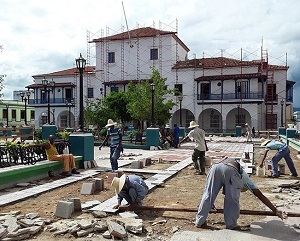 As a key part of the region’s extraordinary history of struggle – beginning with the landing of the Granma expeditionaries and the rebel columns that spread from the Sierra Maestra across the country, culminating with Comandante en Jefe Fidel Castro Ruz announcing the triumph of the Revolution – the José Martí First Front will soon have its own museum here.
As a key part of the region’s extraordinary history of struggle – beginning with the landing of the Granma expeditionaries and the rebel columns that spread from the Sierra Maestra across the country, culminating with Comandante en Jefe Fidel Castro Ruz announcing the triumph of the Revolution – the José Martí First Front will soon have its own museum here.
The only guerilla group of such significance which has not had a specific institution, of this type, will have the ideal headquarters: Santiago de Cuba’s City Hall, directly on centrally located Céspedes Park, from where Fidel announced the Rebel Army’s victory over the dictatorship of Fulgencio Batista, to Cubans and the world, January 1, 1959.
Maylín Santos Suárez, a sociocultural expert with a Masters in Museology and director of the institution, told Granma that the focus on the Rebel Army’s original front serves as a dignified tribute to all those who launched or joined Cuba’s definitive struggle in the mountains, under the undisputed leadership of the Comandante en Jefe.
“The museum,” she said, “will have 12 halls for permanent exhibitions and one for temporary displays, with those located on the first level chronologically covering the history, featuring the Granma expeditionaries’ preparations in Mexico, the crossing, the landing, Alegría de Pío , the first victorious battles in the Sierra, and the contribution of the underground in the cities.
“The seven rooms on the second level will be dedicated to the development and consolidation of the (revolutionary) process through the active participation of women and campesinos, in justice, education, health, religion, workshops, and armories, propaganda; and, of course, the transcendence of the Front in the victory and the subsequent integration of combatants into the work of the Revolution.”
Historical objects to be displayed range from weapons, uniforms, and other equipment of the guerrillas, to fighters’ personal items, belongings of women who joined the Marianas, original documents, and rare photographs, with the main events revisited via advanced technology.”Surely,” emphasized Santos Suárez, “We will be in the presence of a new type of museum, characterized by a balance between the traditional and new technology that such facilities use in the world today, with screens, models, and smart tables featuring sound, colors, and smells that give visitors the sensation of being in the Sierra Maestra’s natural environment.”Participating in the project are specialists from the design team at the City of Havana Historian’s Office, while under the direction of the Santiago de Cuba Curator’s Office (OCC), numerous forces led by the Restoration and Conservation of Monuments Enterprise are in charge of re-conditioning the property and its surroundings.Ramon Cobas Avivar, deputy director of the OCC, explained, “Until a few months ago, the Municipal Assembly of People’s Power occupied this building, which as opposed to what many may think, given its colonial appearance, it is a solid, reinforced concrete building, constructed in 1954, which we must adapt to its new function ».
According to plans, the building will not cease to serve other traditional purposes, with the mayor’s office remaining here, with its Flag Room to receive distinguished guests, the council hall for the awarding of honors, etc, and the formal City Hall where special events are held, while the building will always be the site of Santiago’s traditional flag-raising to welcome in the New Year.
Among the actions projected in other areas, Cobas Avivar referred to the disassembly, treatment, and remounting of the huge Spanish door, of precious wood and metalwork; installation of glass doors and shutters needed to maintain the centralized air conditioning system to be installed; and renovation of sanitary, water, and electrical systems.
Likewise, the decorative Creole tiles on the concrete roof will be restored; an ornamental lighting system installed; and everything repainted. To enhance its surroundings, similar treatment will be afforded the Cathedral, the Diego Velázquez home, the Casa Granda Hotel, the old San Carlos Club, and other buildings on the park.
Intense work is now focused on Cespedes Park and adjacent streets, which have been closed to vehicles, to become pedestrian walkways. On the square, paved areas and sidewalks are being repaired; electrical and telephone cables placed underground; trees replanted; and benches, planters, and lamp posts refurbished, to be ready for the city’s celebrated Caribbean Festival, coming soon.